- Learn, and know what is Comics first of all
- Learn from illustrated books
- Learn from local artists
- Learn from Caricatures, that have created social impacts
- Introspect & Retrospect understandings of Visual Grammar & Communication
yo interested in comics like me ?
DISCLAIMER :
If you are expecting some awesome thing here... Sorry pal... nothing of such sort is here... i am just going to say what i felt sharing... it might be even dumb enough for you.. furthermore, i and this might feel stupid enough for you ditch it.... :D
well ...
For some years now, i have been thinking about having a vector drawing tool that help one to create a comic strip, atleast that has more functionality than the traditional workflow. I used to draw stuff on paper by making visual cues, symbols, icons, sometimes in a fun manner to fortify my interpretation & understanding about what i felt necessary to think. I didn't even know that there has been a name for that. Sketchnoting, Sketchnoting, Sketchnoting. I have been writing and mixing lot of sketch and block diagrams. Obviously Inkscape being the one i have been using for as long as i know.
Being said that, i am a firm believer of Paper, Pencil, Eraser workflow & later transforming into digital space using simple scan, gimp, inkscape or mypaint workflow. I learned a lot about inkscape via this workflow. :)
For so long i have been just an explorer of comics, broadly ranging from cave drawing, to traditional type, to classical to western, to japanese forms -- who have never even thought about learning its grammar, mechanisms, history, present state, its diversity.... etc.
I also believe that there is some degree of artist in every person and so hacker is no different to that. It is very much evident with technological evolution and revolutions, FOSS tools have empowered every known hacker and especially commons to create and share awesome memes. We all do know that it has emerged as a by-product of socio-technical situations. Obviously like every humour, it might root its origins in non-neglectable dark corners of crazy anthropolocial activity. i see memes are fractal forces in todays socio-techno-cultural network ecosystem.
I am one of those folks who born duing mid 1980's and have seen crazy flamboyant and awful transitions humanity has travelled that brought us into current situations. I have witnessed commodification of Water, Soil, Seed, fungus & algae... ; commodification of freely travelling electromagnetic waves; birth, raise and life of Internet, Hacker culture, ... so on. I'm one of the kids who have grown up enjoying Samurai Jack , Captain Planet, & Jonny Quest.
While traveling in internet, me particularly heavily inspired by :
(because i got lot time to read them in research laboratory i was working at :).. ).Around 2011-2012, i learnt :
- how UNJUST LAWs can oppress, subjugate & criminalize independent artists to freely express their views
- how media empires can impose "standards" that are utterly meaningless for art
@ /.\ ----+-----------------------------------------+/ \ | Dude ! Enough ranting, shut ur pie hole | +-----------------------------------------+ +-------------------------------------+---- ( me ) | Yea, ok, i got carried away..... :D | +-------------------------------------+
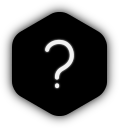
THE MORE MANUAL WAY :
i follow a straight forward workflow like :

STEP 1
STEP 2
- Let ur artistic mind imagine characters, & use them to draw the story
- Use Paper, Pencil & Eraser to evolve a composition
- Add dynamics for expression using grammar techniques and tricks
STEP 3
- Scan the paper (simple scan)
- Adjust raster image properties (gimp)
- Trace the scanned image into vector graphics (inkscape)
- Edit nodes and add required additional paths, symbols
- Add visual dynamics, dialog balloons, fun ...
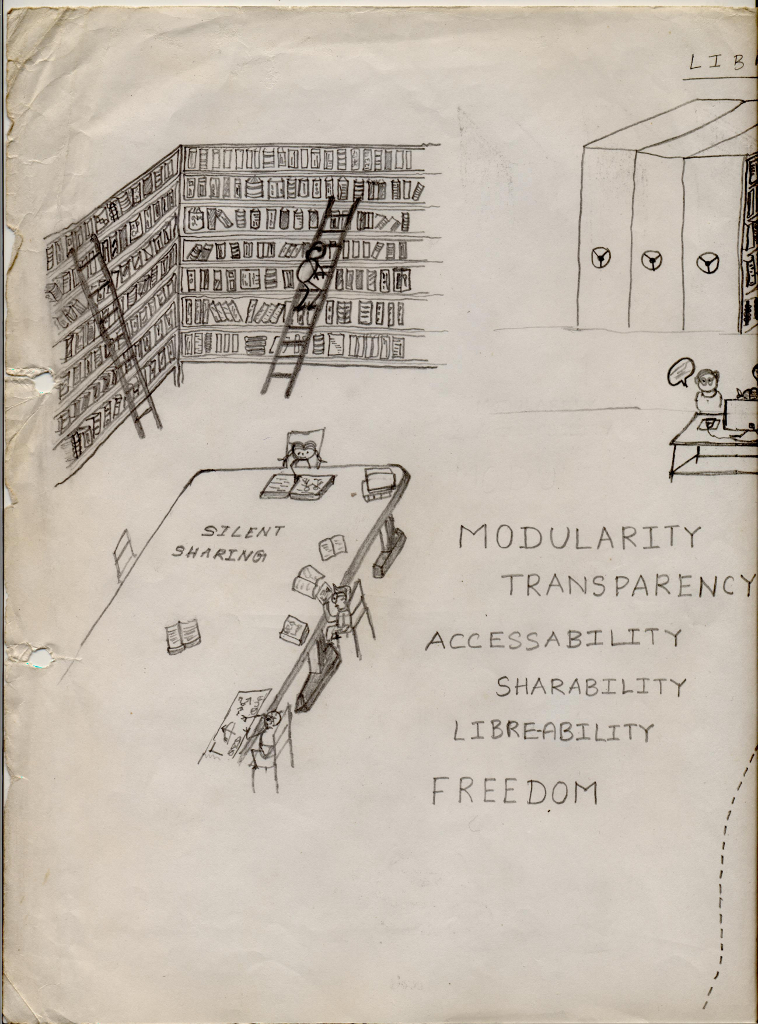
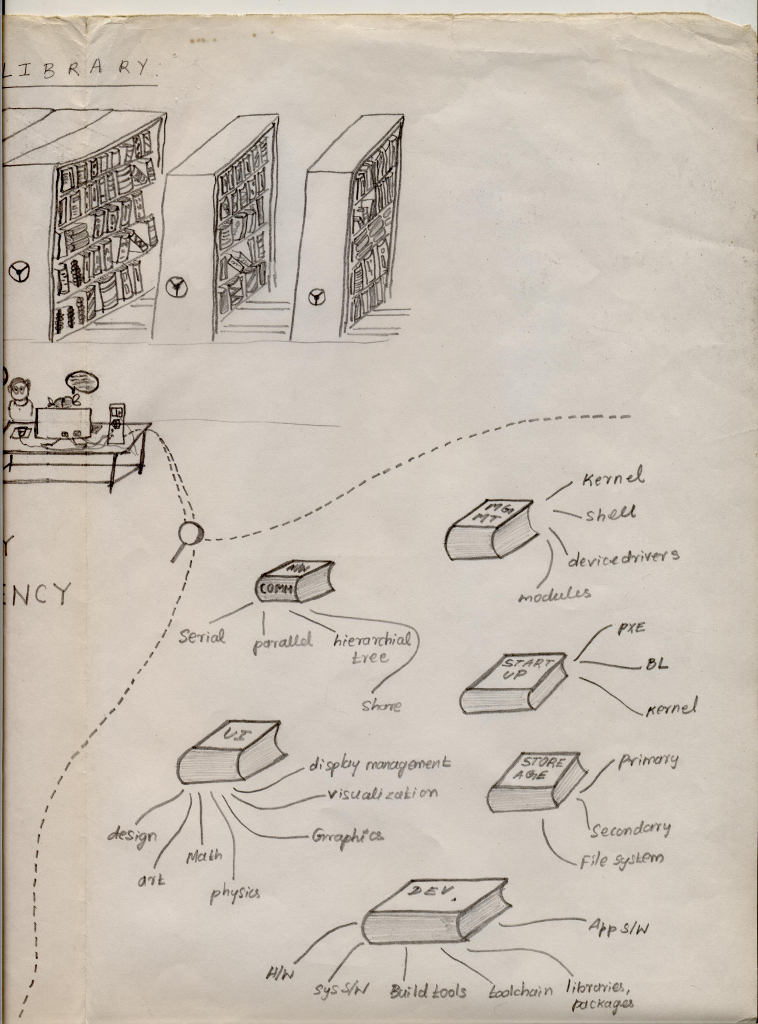

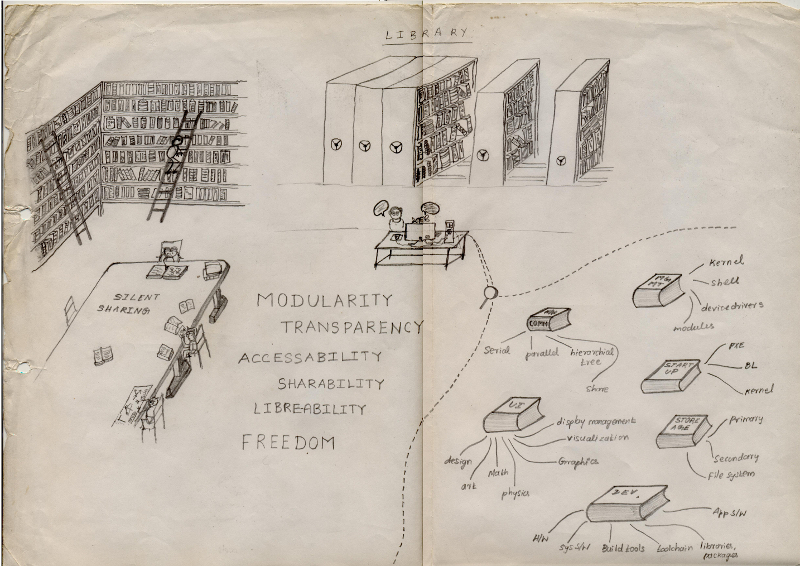

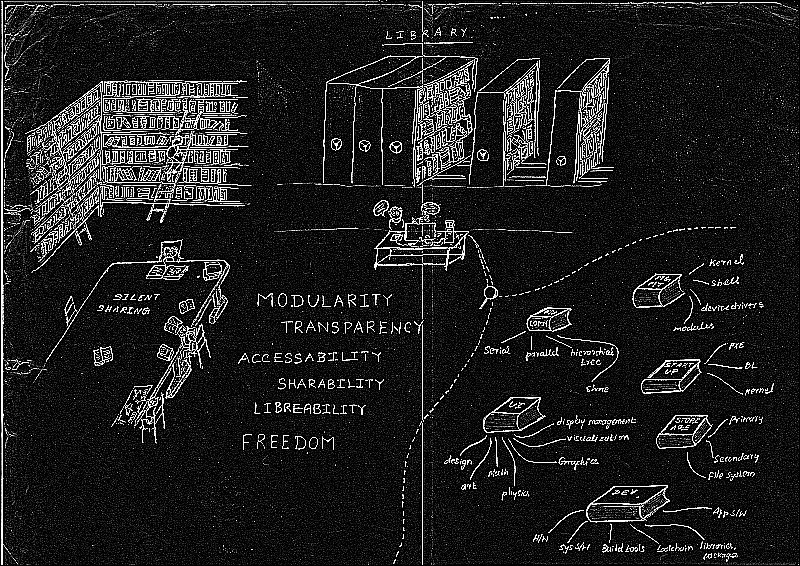

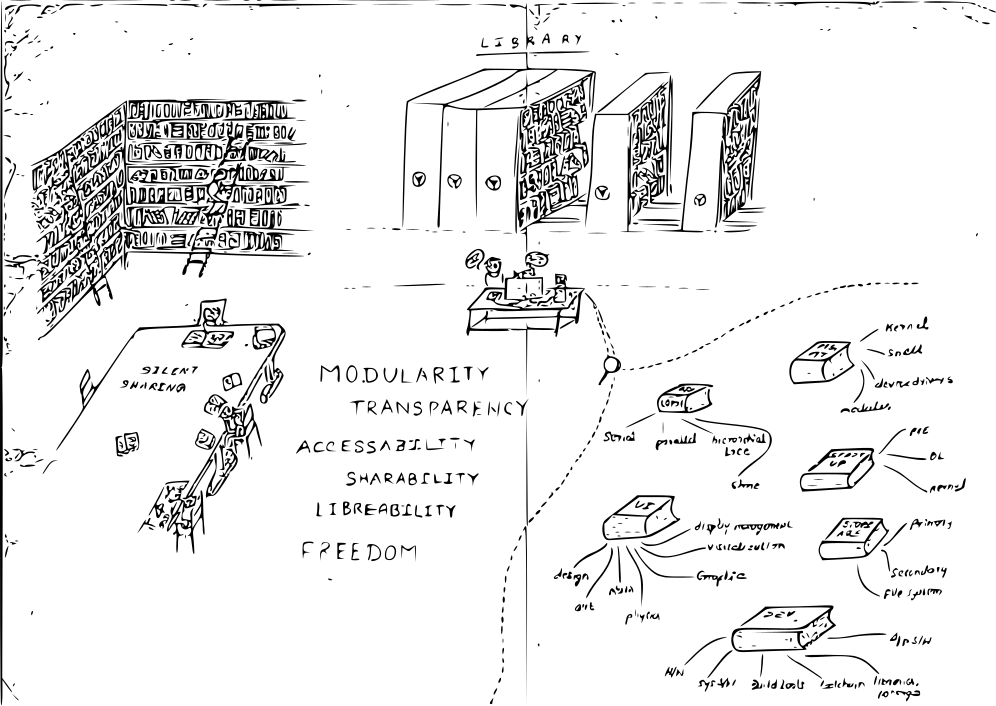
STEP 4
- Review it as if you are the reader
- Add suitable license
- Convert it into suitable image format without much loss
- Post it in your website or in a common forum
@ /.\ ----+----------------------------------------------+/ \ | Bull Shit !... that is not a comic in making | +----------------------------------------------+@ /.\ ----+------------------------------------------------+/ \ | it is just digital image processing in action !| +------------------------------------------------+ +----------+--- ( me ) | Yeah, :D | +----------+@ /.\ ----+----------------------------------------------------------+/ \ | Seriously ? by the way, your "comic" looks like dry shit | | Our conversation are way better than your "comic"... | | dont u ever write an article about comic... or i will | | resurrect, and faaaaking crucify you.... | +----------------------------------------------------------+
@ /.\ ----+-----------------------------------------------------+/ \ | Really ! when are u going to say the other method ? | +-----------------------------------------------------+ +------------+--- ( me ) | will do... | +------------+
Dudes, fun apart, but seriously when i was searching for inspiration to learn comics, to gain some insight, in terms or simplicity, cuteness, fun, expression without any extra muscle of flamboyance.... i stumbled upon Neil Slorance, whose comics and illustrations felt much lighter and provide a long lasting effect which i feel is actually hard to bring about in any comic without overloding the reader with lot of information.
We know that, actually a comic is actually a way of expression like mathematics, or a canvas painting, or a novel writing phenomenon. As a learner, i felt that transforming what we think with brain in our mind, to papers in the form we like to express for whatever reason is the real challenge. It seriously involves something called as Biofeedback mechanism, that heavily influences our congnitive information processing system which again recursively drives in making more of the thing which we felt much fun and curious in continuing do it, which further reinforces the habit and search for the required resources and themes in order to feed the expression again and again.
Whether it is XKCD, or Sidewalk bubblegum or PHD comics, or neil slorance, or even U or I, the expression starts in mind and flows in paper/canvas, avalanches back to mind and continues back and so on... The digital stuff of making it more appealing is just for broadening the communication for which the author feels that particular creation deserve propagation. Even though i feel, that no comic requires meta data to be transferred along with the creation as almost every human could able to reverse engineer the comic and guess approximately what might be tools used to create when drawn by hand.
Having said that, i also felt that if some system is available to embed the meta data of how the comic is created, with what kind of tools, inspiration, license, along with author information would offer better insight for learners who are yet to know about those intricate stuffs. Sincerely, i do not know whether comic file formats offers any help in this perspective.
could a machine draw comic ???
@ /.\ ----+------------------------------------------------------+/ \ | yo, it is like asking : can machines sing or dream ? | +------------------------------------------------------+
Nowadays, with much active contribution towards AI, & Machine learning we can say that neural networks - that are modelled based on a brains conception of neural network could produce some manifestations that have significant artistic dimension to it. For instance, inceptionism have gained recent traction towards such an approach, which in turn have influenced in theorizing what could psychedelic experience has to offer !
THE SEMI VIRTUAL WAY :
Here the virtual drawing is used by both learners and experts, with later using more to produce digital art straight in the screen. A Wacom device has to be purchased (i believe some of its make have open drivers) and interfaced with a GNU/Linux box, work with tools like GIMP, Inkscape, to draw object by object, character by character, effects by effects redoing the prototype drawing in a much satisfied way. Redoing the already satisfied paper drawing is literally waste of time. Here people often mix the manual method along with this to produce a better art in their own way.
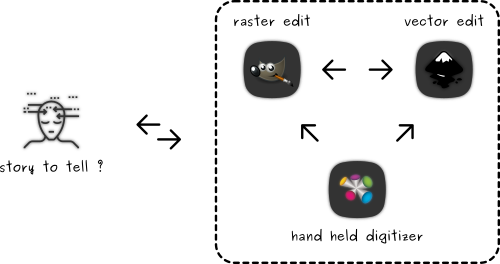
With this method, there is a significant improvement in BioFeedback cycle, if the author is comfortable in using the devices and digital tools for making a comic. For those who are not comfortable with devices for drawing, and have settled at peace with paper, pencil, scan method - this method - on contrary would test the sanity until the artist brain trains itself to fit this process.
THE OTHER WAY :
This method or just a way could be seen as a semi machine version of doing a comic, which is already a cultural practice propagated and mastered by the hacker community tagged with humour. It has transparency, propagation, regeneration, similarity, set of repeated characters which makes it easy for anybody to express their thought with humour or dissent by integrating these into a single strip easily.

What would it be like, if we collect all the characters used in XKCD for instance so far, digitize them; find similar style traits that resemble Randall Munroe's drawing, add a bit of our own story to it, and produce comics ranging from stupid ones to near awesome ones. It is a fact, that for every awesome comic strip we have so far, there might be so many tryouts, iterations, versions of either imagination or drawing before what we percieve as the final comic !. If the authors are independent, then they would have their own mental calibration which they would not compromise and might be steeply rising with every comic they make.
STEP 1
- Imagine up the frames/scene and create the composition
- Draw the composition in paper (rough drafts) or directly using a Raster program (Gimp) or Vector program (Inkscape)
Most of the time, the rough prototype will almost complete the transformation required for expression along with a story and style which might be unique to the author and idea/views. For example, the following comic, drawn by Neil Slorance might be a try out. Even if it is not, let's assume it is... (i hope Neil Slorance would not get angry with this crazy article) for the sake of discussion...

@ /.\ ----+----------------------------------------------+/ \ | i wonder, whether did u republished his pic, | | with consent ? | +----------------------------------------------+
Now to have a full fledged digital flow, one has to collect all the objects, characters, effects used in the comic. For instance in the above comic, first the canvas is composed with 4 individual frames that have specific focus on different objects, views, effects etc, related in time - forming a sequential comic. This communicates 4 states of the sequence which lets our brain to fill up the gaps between the frames. Could you get the idea ??? Less Information, More Generation (similar to mathematical interpolation). Here it is upto the artist to select which particular frame in the story has to select to create the composition in their unique style. Infinite no. of possibilities are there to select from the list of sequences separated with time. But this selection guides the reader with ease or with interesting sparkling effects they would feel as they fill the gaps with their imagination.
For instance, let us create a example composition in XKCD style... It usually consists of a box with squiggly stuff.


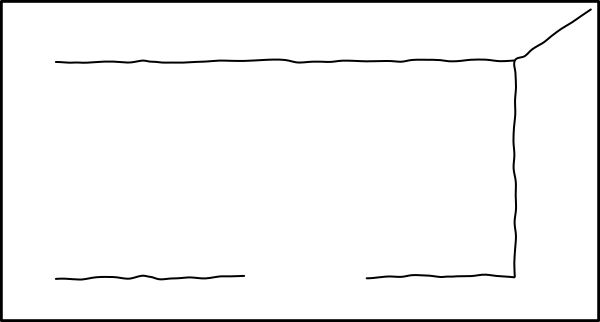
STEP 2
- Add Grammar
- Include Characters
- Include Objects
- Include Effects
A frame in a composition of the comic, is made up of several instances of elements as listed above. But the whole is always greater than the sum of all this components. Why ? because relationships between characters emerge from the story line and their reactions and behaviors influenced by the language, style, and effects added to that particular frame which then continues to flow to the next frame and so on... One can add color paints if interested, but usually a pencil shade would give a simple understanding of dimension and perspective. Later that can be emphasized with water colours/blur effects etc..
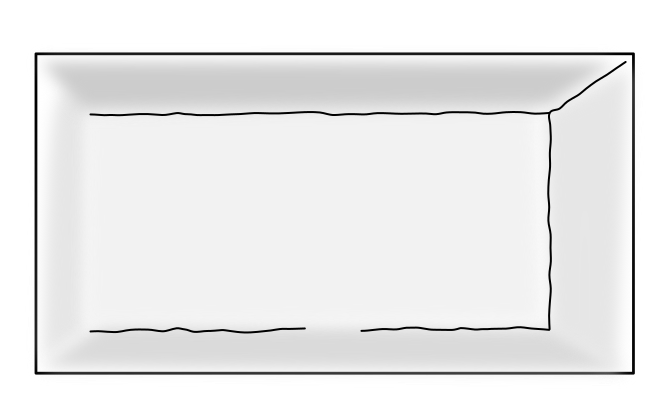


Certainly, to make a well satisfied art, one might want to search the digital manifestations of abstract objects, characters, effects, resulting in a comic or meme or digital art. This clearly denotes that we require a huge corpus that organizes the collection of such elements and lets us search the stuff that are in need. Well, Internet and collaborative web platforms could offer such resources, still what ones imagination asks for can only be matched through ones own work of hand -- by Pencil, Paper, Eraser way. So what one could digitize and store the comic elements (primitive & abstract) and form their own library which could be easily stored locally and mixed with elements shared by fellow artists. With gradual accumulation of such elements, (which are optimally editable - so that it can be appropriately fitted to the story line - as in SVG.) the amount of work to redraw the same character once again the same character in future creations will be saved.
For instance, any body who likes XKCD, would most probably have the collection, and used in one way or other in their creation atleast somewhere along the way. From such collection, one can extract i.e, disentangle elements separetly from the frame, and make a respository of characters, objects, dialog balloons, cool verb effects, etc... This created repository acts as a base, and further edits are appended to the library which makes it more diverse and contiguous. Even one could train a ML algorithm to generate all possible intermediate elements from the available ones.
Think about it, with an animation studio like, Synfig, even animations can be produced. Nowadays we have collaborative icon making and sharing platforms and similarly comics can also be done. People are seriously looking for Shared Canvas plugin/feature in widely used drawing & animation tools, that would simply provide a board/wall/canvas for multiple artists to work at the same time as a team. This could be scaled to multiple boards, multiple artists. However, it will pose a huge computation demand and tight networking platform that might work well in LAN of short distances with negligible route length and loss.
The above practice, usually keeps the human and the machine at balance, by doing things what they are good at doing. Furthermore, the interface offers insight into each others domain expertise and lets innovate many other side effects.

I traced the XKCD bitmap image to extract the characters from the comic, and reused them as above. This is what we can term as vectorizing.
Create frames similar to above one, based on your funny idea or view of a certain matter, and try to express it with humour, rage, dissent whatever... with the elements like xkcd characters, open fonts, along with vector tools that help extract the elements.







